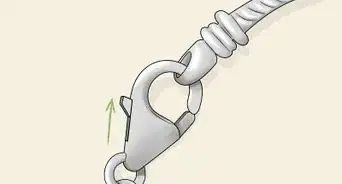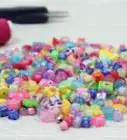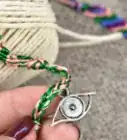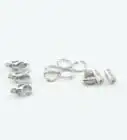X
wikiHow is a “wiki,” similar to Wikipedia, which means that many of our articles are co-written by multiple authors. To create this article, 18 people, some anonymous, worked to edit and improve it over time.
This article has been viewed 320,110 times.
Learn more...
You always see those kandi kids walking around with their bright bracelets. Maybe you want to have some too.
Steps
-
1Pick your beads. Although any kind of bead could be used to make kandi, typically plastic beads are used. There are many different kinds of plastic beads though, and each offers a unique and interesting looks for your kandi!
- Pony beads are the classic; big, round-edged beads that we all used as kids. These will give a chunky feel to your kandi.
- Perler beads are smaller than pony beads but equally classic. These are the ones that could be placed in a mold and ironed over to create a solid, rainbow-hued plastic figure. These have straight edges, but are good for creating patterns in a cuff.
- Peyote beads are similar to perler beads but have rounded edges and are sometimes made of glass. Think of them as a wider, smaller version of pony beads. These will give you the most intricate patterns, but are also the most difficult to work with.
-
2Choose a type of string. Most styles of string will do as long as they have a bit of elastic in them to allow for stretch.
- Using an elastic plastic string gives you the opportunity of continuing with the plastic theme the beads have, but is not as comfortable as cloth string. Plastic string begins to dig into your wrist over time and is therefore not preferred.
- Cloth string with a bit of elastic is a good option as long as the string is not too wide.
- Be sure that whatever string you use is thin enough that it could easily fit through any one of your beads twice.
Advertisement -
3Gather all remaining supplies. These will include a pair of scissors and, should you choose to use them, clasps to close the bracelet with.[1]
Advertisement
Method 1
Method 1 of 2:
Making a Single Strand Piece of Kandi
-
1Measure your string. To do this, wrap the string around your wrist and add an extra two inches of length to tie off the ends.
-
2Choose your beads. You may want to decide on a pattern before you start stringing, or you might want a random selection of beads. Either way, it is good to make that decision before you start putting your kandi together.
-
3Prepare your string. If you are using a clasp, you will need to attach one of the clasps to one end of the string; this will be the end your beads rest on. If you aren’t, fold the elastic in half. You'll have to be careful when threading the beads in the next steps to always hold on to both ends, so no beads slip off.
-
4String your beads. For a single-strand piece of kandi, there is no special way to string them. It’s all up to you! Put enough beads on the thread that it is completely full except for an inch at the end.
-
5Finish your bracelet. Tie off the end of your kandi with a knot. If you used clasps, add the second class to the end of the bracelet. If not, then simply use the two loose ends to tie in a knot around your wrist.
-
6Now go show off your craftsmanship!
Advertisement
Method 2
Method 2 of 2:
Making a Kandi Cuff
-
1Measure your string. Similar to making a single-strand piece of kandi, wrap your string around your wrist to get an estimated length. Then, unravel your string so that you have a significant amount more, about three feet in excess (3 feet makes about 8 rows).
-
2Begin beading your cuff. Choose a pattern of beads that you want; this could be very simple and geometric or a complete image. Many websites offer patterns you can use to produce an image on your cuff. Place enough beads on the string to completely encircle your wrist.
-
3Tie the circle shut with a knot. You'll end up with one short end and one very long end of elastic. You will continue adding rows of beads onto the long end.
-
4Make a second row of beads. To do this, continue past the stopping point of the first row in a circular pattern one row above. In the second row, string your thread every-other bead through a bead below it in the first row. This means your beads will be staggered between rows, not lined up vertically.
-
5Continue making new rows. Follow the same step as in #3, where you thread your string through a bead in the row below it every-other bead. Continue this for as many rows as you like, or until you run out of string. By this time, if you used elastic thread, your rows should start to stand up creating the more obvious cuff shape.
- Tip: Always thread through the next high row bead.
-
6Finish your cuff. Do this at the end of a complete row so that your cuff is even. Thread your string through the last bead in the row beneath it and tie it off.
-
7Show off your work! Your cuff is now completed, and is ready to be worn or gifted as a token of friendship.[2]
Advertisement
Community Q&A
-
QuestionDoes Kandi have anything to do with drugs?
 Felicia AxelssonCommunity AnswerKandi is associated with rave and EDM culture, and it depends on who you ask. Raves are to some people associated with drugs, so by extension, sometimes kandi is too. But it is never surefire, you can wear kandi without having anything to do with drugs.
Felicia AxelssonCommunity AnswerKandi is associated with rave and EDM culture, and it depends on who you ask. Raves are to some people associated with drugs, so by extension, sometimes kandi is too. But it is never surefire, you can wear kandi without having anything to do with drugs. -
QuestionHow do you get the second row on? Do you use another piece of string or the same one?
 Adorkable SanaCommunity AnswerPut the thread back through the first bead, and then add a bead and put the thread back through the third bead you initially put on, and so on. You just use a kind of long piece of string, but you can add on more string if you need to.
Adorkable SanaCommunity AnswerPut the thread back through the first bead, and then add a bead and put the thread back through the third bead you initially put on, and so on. You just use a kind of long piece of string, but you can add on more string if you need to. -
QuestionDoes it take a long time to make?
 AnotheronebitesthesoilCommunity AnswerLarge, intricate cuffs can take a while. Try single row bracelets if you are short on time.
AnotheronebitesthesoilCommunity AnswerLarge, intricate cuffs can take a while. Try single row bracelets if you are short on time.
Advertisement
References
About This Article
Advertisement

















































